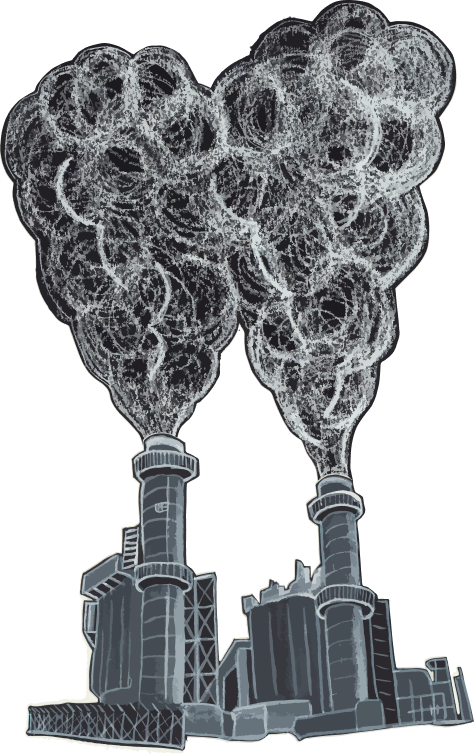Wisconsin
Back to mapTo get to zero by 2050, Wisconsin must cut emissions by 3.7% a year
Emissions in Wisconsin
Million metric tons of carbon dioxide (CO2) [?] equivalent (MTCO2e [?]) emissions
Note: Grey area indicates missing data due to processing delays.
Source: WRI, Mar 2021
This is how we're going to do it
- Boilers and furnaces with heat pumps [?]
- Gas stoves with electric induction stoves [?]
- No-till farming to keep CO2 in the soil
- Capturing methane leaks from landfills
- Capturing CO2 to make emissions-free concrete
- Burning green hydrogen to make emissions-free steel
- Plugging methane leaks from gas pipelines
Decarbonize Our Buildings
13% of Wisconsin's climate pollution comes from buildings.
We burn fossil fuels to heat our air, water, and food.
To cut this pollution...
Let's electrify our heat!
We'll replace...
...in all of Wisconsin's 3.2 million buildings.
In fact, 23% of appliances in buildings in Wisconsin are already fossil fuel free!
That means we only need to electrify the remaining 2.5 million dirty buildings in Wisconsin. That's around 91,000 per year.
Source: Microsoft, Mar 2021; NREL, Dec 2021Electrifying all buildings cuts 13% of the pollution.
Decarbonize Our Transport
24% of Wisconsin's pollution comes from cars, trucks, trains, and planes.
But mostly from cars.
To cut this pollution,
your next car must be electric.
Or consider going car-free with public transit, bikes/e-bikes, car share, or other alternatives!
There are 1.9 million vehicles in Wisconsin and 6,000 are already electric (0.3% of the total).
We need to electrify (or replace) the remaining 1.9 million gas-powered vehicles. That's around 70,000 a year.
Source: DOT, Feb 2021Electrifying all transportation cuts 24% of the pollution.
Decarbonize Our Power
30% of Wisconsin's pollution comes from burning coal, gas, and oil to make power.

To cut this pollution...
Put solar panels on your roof!
Then, we'll replace all fossil fuel power plants with solar and wind farms.

...and find good jobs for those workers.
Current Fossil Fuel Power Plants in Wisconsin
9 coal plants
Elm Road Generating Station
Milwaukee County
1,403 MW
South Oak Creek
Milwaukee County
1,260 MW
Weston
Marathon County
1,163 MW
Columbia
Columbia County
1,112 MW
Edgewater (4050)
Sheboygan County
834 MW
J P Madgett
Buffalo County
387 MW
Genoa
Vernon County
346 MW
Biron Mill
Wood County
62 MW
Kaukauna Paper Mill
Outagamie County
45 MW
35 gas plants
Port Washington Generating Station
Ozaukee County
1,548 MW
Riverside Energy Center
Rock County
1,402 MW
Pulliam
Brown County
671 MW
Fox Energy Center
Outagamie County
619 MW
12 oil plants
Manitowoc
Manitowoc County
213 MW
Diesel Generators
Dane County
54 MW
Cumberland (WI)
Barron County
22 MW
New Lisbon
Juneau County
9 MW
Fennimore
Grant County
7 MW
Elroy
Juneau County
7 MW
Grantsburg Diesel
Burnett County
6 MW
Winter
Sawyer County
6 MW
Washington Island
Door County
5 MW
Argyle
Lafayette County
5 MW
Marathon Electric
Marathon County
3 MW
WPPI Hartford DG
Washington County
1 MW
But wait!
It's not enough to replace our power plants with wind and solar farms.
To power our electric cars and buildings, we need two times the electricity we have today.
In all, we'll need to build 8,000 megawatt (MW) [?] of wind power and 7,000 MW of solar power.
Since the average wind turbine provides 2.75 MW of peak capacity, Wisconsin would need to install about 3,000 turbines.
Since Wisconsin already has 184 MW of wind and 66 MW of solar, that's 8,000 MW of wind power we need to build and 7,000 MW of solar power. That's around 279 MW of wind power and 264 MW of solar power a year.
Source: EIA, Apr 2022Decarbonizing all dirty power cuts 30% of the pollution.
And gives us zero-emissions power we need to eliminate pollution from buildings and cars!
Other Emissions
The last 32% of Wisconsin's climate pollution comes from other sources...
This includes farming, landfills, industry, and leaks from gas pipelines.
There's no one solution to solve these problems, but there are lots of great ideas:
That doesn't mean there's no solution, it just means that clean electrification [?] doesn't help with these problems, and you could fill a whole book with covering all of them. We need to encourage our politicians to invest in researching new solutions and implementing existing solutions to these problems!
Ready to do your part?
Learn how to electrify your own machines and pass local policy to electrify the rest
Take Action